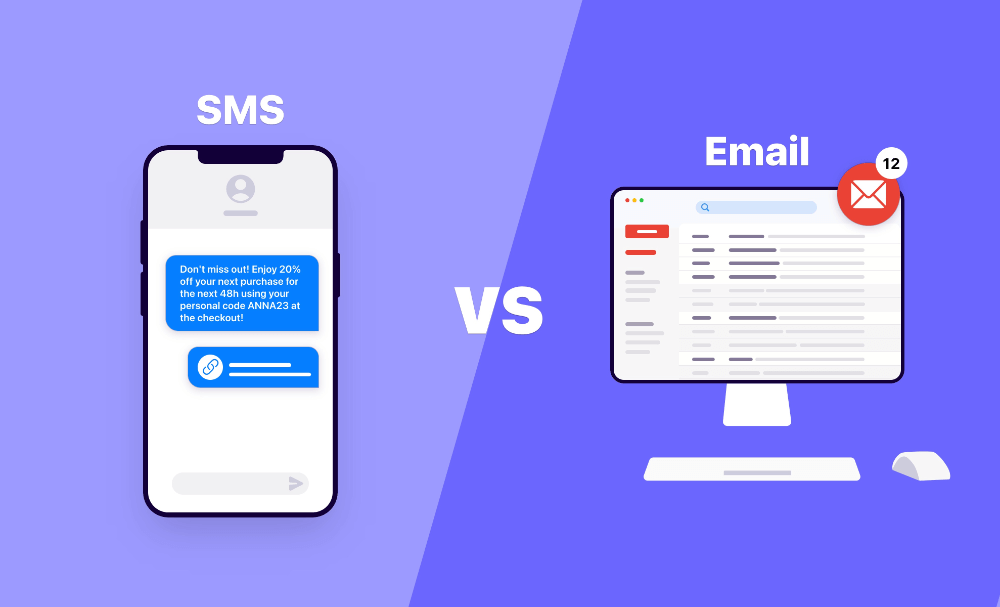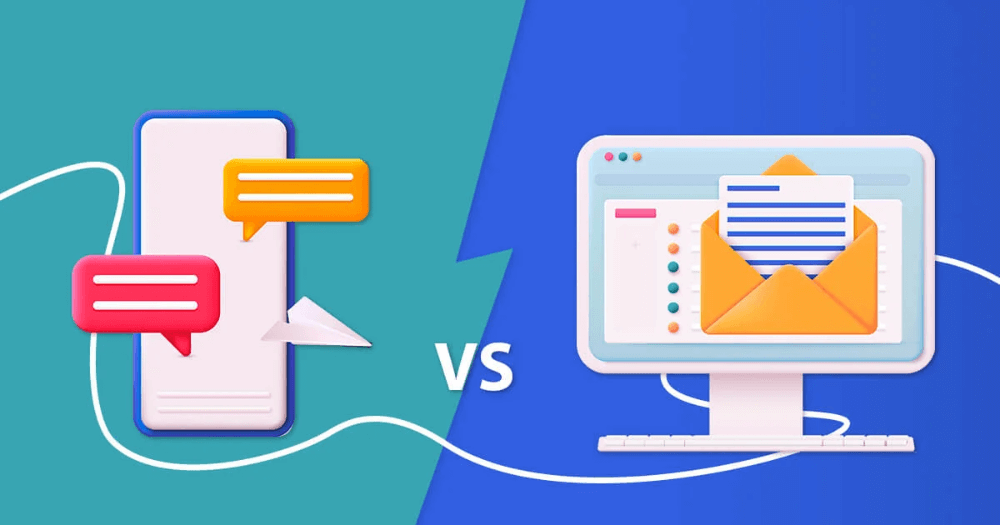📑Table of Contents:
- What Is Email Marketing?
- What Is Text Messaging (SMS) Marketing?
- Email vs. Text Messaging: The Key Differences
- When to Use Email
- When to Use Text Messaging
- The Power of Combining Email and SMS
- Privacy and Compliance Considerations
- Analytics and Performance Tracking
- Pros and Cons at a Glance
- Real-World Examples
- The Future of Digital Communication
- Final Thoughts

In today’s fast-paced digital world, businesses rely heavily on communication tools that keep them connected to their customers. Two of the most powerful options are email and text messaging (SMS). While both serve similar purposes — reaching audiences and delivering information — they differ in speed, engagement, and impact.
So, which one should you focus on? Let’s explore how email and text messaging compare, when to use each, and how combining both can deliver the best results.
What Is Email Marketing?
Email marketing is one of the oldest and most trusted digital communication channels. It involves sending messages, offers, newsletters, or announcements to a list of subscribers. Businesses use email to build relationships, share updates, and drive conversions.
Emails allow for detailed communication. You can include long text, images, videos, and links. Moreover, they’re ideal for professional and in-depth conversations.
What Is Text Messaging (SMS) Marketing?
Text messaging, or SMS marketing, sends short, direct messages to mobile phones. It focuses on simplicity and immediacy. Unlike emails, SMS has strict character limits, which forces marketers to be concise.
Texts are often used for reminders, alerts, promotions, and time-sensitive offers. Because messages reach users instantly and don’t require internet access, SMS remains one of the most reliable communication methods.
Email vs. Text Messaging: The Key Differences
Although both channels deliver messages, they work very differently. Let’s break down their main differences.
1. Open and Response Rates
Text messages win this round easily. Studies show that SMS open rates exceed 90%, while emails average between 20–30%. Most text messages are opened within minutes, whereas emails can sit unopened for hours or even days.
Additionally, response rates are far higher with texts. People reply to text messages much faster because they’re simple and convenient.
2. Content Length and Design
Emails allow for longer, more visual content. You can include banners, graphics, and multiple links. This makes them perfect for storytelling or sharing detailed information.
On the other hand, SMS is short and to the point. With a 160-character limit, every word counts. However, this brevity can be an advantage because it forces clarity and encourages quick action.
3. Cost and ROI
Both email and SMS marketing can be cost-effective, but costs vary. Email campaigns are generally cheaper per message, especially for large lists. However, the return on investment depends on engagement.
SMS marketing may cost more per message, but its high open and response rates often justify the expense. In fact, for urgent or high-value campaigns, SMS can deliver a faster ROI.
4. Personalization and Targeting
Both channels support personalization, but in different ways. Emails can use names, purchase history, and behavior tracking to create tailored content. SMS also allows personalization but focuses on short, relevant messages.
For instance, an email might include a full product recommendation list, while an SMS might simply say, “Hi Sarah, your favorite moisturizer is 20% off today!”
5. Speed and Delivery
SMS is instant. Messages typically reach recipients in seconds. Email delivery, on the other hand, depends on inbox filters, timing, and user habits.
For time-sensitive alerts — such as flash sales, appointment reminders, or emergency notices — SMS wins hands down.
6. Audience Reach and Accessibility
Email requires an internet connection and a device capable of viewing HTML content. SMS only needs a phone signal, which means it reaches users even in low-connectivity areas.
However, email has broader global reach for professional communication and is less intrusive. That’s why many businesses use both — each serving a specific purpose.
When to Use Email
Email is perfect for long-form content, professional communication, and relationship building. Use it when you need to:
- Share newsletters or educational content
- Send receipts, invoices, or detailed confirmations
- Nurture leads with multi-step campaigns
- Communicate brand stories and product updates
- Deliver personalized offers that require visuals or links
Emails give you the freedom to design and explain in depth, making them ideal for brand development.
When to Use Text Messaging
SMS is best for quick, action-oriented communication. Use it when you want to:
- Send reminders or appointment confirmations
- Announce flash sales or limited-time discounts
- Share delivery updates or service alerts
- Send two-factor authentication codes
- Provide customer support updates
Because texts are short and immediate, they’re perfect for engaging customers in real time.
The Power of Combining Email and SMS
Instead of choosing one channel, the smartest businesses use both. Email and SMS complement each other perfectly.
For example, you can send an email with full campaign details and follow up with a short text reminder. You can also use SMS to alert customers to check their inbox for more information.
When used together, these channels create a seamless communication experience — one that reaches users on multiple touchpoints and increases the chances of engagement.
Example Workflow
- Email – “Your summer sale starts tomorrow! Check out our deals.”
- SMS Reminder – “The summer sale is live! Shop now before midnight.”
This simple combination can double engagement compared to using just one channel.
Privacy and Compliance Considerations
Both email and SMS must follow privacy regulations. For emails, laws like CAN-SPAM and GDPR require businesses to obtain consent and include an unsubscribe link.
For SMS, TCPA and similar regulations apply. You must secure explicit opt-in permission before sending messages. Always allow customers to opt out easily.
Respecting privacy builds trust and protects your brand reputation.
Analytics and Performance Tracking
Tracking metrics helps you improve campaigns over time.
- Email metrics: open rates, click-through rates, bounce rates, unsubscribe rates, and conversion rates.
- SMS metrics: delivery rates, open rates, response times, and opt-outs.
By comparing both, you can see which performs better for specific goals. For example, SMS might outperform for reminders, while email might work better for educational content.
Pros and Cons at a Glance
| Feature | SMS | |
|---|---|---|
| Open Rate | 20–30% | 90%+ |
| Response Speed | Slower | Instant |
| Message Length | Long | Short |
| Design Flexibility | High | Low |
| Cost Per Message | Low | Moderate |
| Reach | Global | Universal (mobile) |
| Urgency | Moderate | High |
| Opt-In Needed | Yes | Yes |
Both channels offer clear strengths. The best choice depends on your audience, timing, and campaign goals.
Real-World Examples
A retail brand might send promotional emails showcasing new products, followed by a quick SMS reminder on the day of a sale.
A healthcare provider might email appointment details, then send a text reminder 24 hours before the visit.
Similarly, an event organizer could email tickets and send SMS notifications about last-minute changes. Each example shows how email and SMS can work together to boost results.
The Future of Digital Communication
The future isn’t about choosing between email and SMS — it’s about integration. Businesses now aim for omni-channel strategies, blending both tools with push notifications, social media, and in-app messaging.
As technology evolves, personalization will improve, automation will get smarter, and analytics will become more detailed. The goal will remain the same: reaching customers in the right way, at the right time, with the right message.

Final Thoughts
Both email and text messaging are vital for modern communication. Email excels at storytelling, branding, and long-form engagement. SMS wins in speed, simplicity, and urgency.
Instead of asking which is better, focus on how to use both effectively. Send rich, detailed messages through email and reinforce them with quick, timely SMS reminders.
When you combine these channels strategically, you’ll strengthen relationships, improve engagement, and drive better results across every stage of the customer journey.
